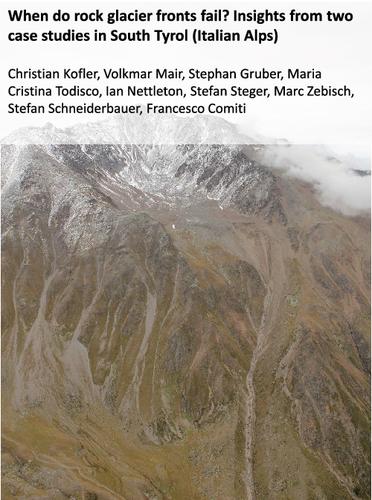当前位置:
X-MOL 学术
›
Earth Surf.Process. Land.
›
论文详情
Our official English website, www.x-mol.net, welcomes your
feedback! (Note: you will need to create a separate account there.)
When do rock glacier fronts fail? Insights from two case studies in South Tyrol (Italian Alps)
Earth Surface Processes and Landforms ( IF 2.8 ) Pub Date : 2021-02-19 , DOI: 10.1002/esp.5099 Christian Kofler 1, 2 , Volkmar Mair 3 , Stephan Gruber 4 , Maria Cristina Todisco 5 , Ian Nettleton 5 , Stefan Steger 1 , Marc Zebisch 1 , Stefan Schneiderbauer 1, 6 , Francesco Comiti 2
Earth Surface Processes and Landforms ( IF 2.8 ) Pub Date : 2021-02-19 , DOI: 10.1002/esp.5099 Christian Kofler 1, 2 , Volkmar Mair 3 , Stephan Gruber 4 , Maria Cristina Todisco 5 , Ian Nettleton 5 , Stefan Steger 1 , Marc Zebisch 1 , Stefan Schneiderbauer 1, 6 , Francesco Comiti 2
Affiliation

|
The fronts of two rock glaciers located in South Tyrol (Italian Alps) failed on 13 August 2014, initiating debris flows in their downslope channels. A multimethod approach including climate, meteorological, and ground temperature data analysis, aerial image correlation, as well as geotechnical testing and modeling, led to the reconstruction of the two events. An integrated investigation of static predisposing factors, slowly changing preparatory factors, and potential triggering events shed light on the most likely reasons for such failures. Our results suggest that the occurrence of front destabilization at the two rock glaciers can only partly be explained by the occurrence of heavy rainfall events. Indeed, antecedent hydrological and thermal ground conditions were characterized by a saturated active layer favored by a snow‐rich winter and extensive precipitation in late spring and summer. Also, the rising trend of air temperature during spring and summer months since 1950s might explain the concurrent marked displacement of the two rock glaciers. Indeed, geotechnical investigations have provided strong indications that one of the investigated rock glacier fronts was at a marginally stable state prior to 2014. As rainfall events more intense than the one that occurred in August 2014 were previously recorded in the same area without resulting failures at the studied rock glaciers, we propose that both predisposing and preparatory destabilizing factors have played a key role in the 2014 rock glacier front failures.
中文翻译:

冰川冰川前沿何时会失效?来自南蒂罗尔(意大利阿尔卑斯山)的两个案例研究的见解
2014年8月13日,位于南蒂罗尔(意大利阿尔卑斯山)的两座岩石冰川的前缘破裂,在其下坡通道中引发了泥石流。包括气候,气象和地面温度数据分析,航空影像关联以及岩土工程测试和建模在内的多方法方法导致了这两个事件的重建。对静态诱发因素,缓慢变化的准备因素和潜在触发事件的综合研究揭示了此类失败的最可能原因。我们的结果表明,这两个岩石冰川前缘不稳定的发生只能部分由暴雨事件的发生来解释。确实,以前的水文和热力地面条件的特征是饱和的活动层,冬季多雪,春季晚些时候和夏季都有大量降水。另外,自1950年代以来的春季和夏季,气温升高的趋势可能解释了两个岩石冰川同时出现明显位移的原因。确实,岩土工程勘测提供了强有力的迹象,表明所调查的岩石冰川前沿之一在2014年之前处于边缘稳定状态。由于降雨事件比2014年8月发生的降雨事件更为强烈,因此以前曾在同一地区记录到降雨事件,但并未造成破裂。对于研究过的冰川,我们认为诱发和稳定的不稳定因素都在2014年冰川前缘破坏中发挥了关键作用。
更新日期:2021-03-26
中文翻译:

冰川冰川前沿何时会失效?来自南蒂罗尔(意大利阿尔卑斯山)的两个案例研究的见解
2014年8月13日,位于南蒂罗尔(意大利阿尔卑斯山)的两座岩石冰川的前缘破裂,在其下坡通道中引发了泥石流。包括气候,气象和地面温度数据分析,航空影像关联以及岩土工程测试和建模在内的多方法方法导致了这两个事件的重建。对静态诱发因素,缓慢变化的准备因素和潜在触发事件的综合研究揭示了此类失败的最可能原因。我们的结果表明,这两个岩石冰川前缘不稳定的发生只能部分由暴雨事件的发生来解释。确实,以前的水文和热力地面条件的特征是饱和的活动层,冬季多雪,春季晚些时候和夏季都有大量降水。另外,自1950年代以来的春季和夏季,气温升高的趋势可能解释了两个岩石冰川同时出现明显位移的原因。确实,岩土工程勘测提供了强有力的迹象,表明所调查的岩石冰川前沿之一在2014年之前处于边缘稳定状态。由于降雨事件比2014年8月发生的降雨事件更为强烈,因此以前曾在同一地区记录到降雨事件,但并未造成破裂。对于研究过的冰川,我们认为诱发和稳定的不稳定因素都在2014年冰川前缘破坏中发挥了关键作用。











































 京公网安备 11010802027423号
京公网安备 11010802027423号